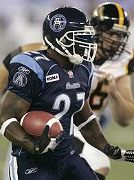|
Ricky Williams enters the CFL with great credentials, but he's definitely not considered the ideal CFL back. He's a big back in a league built for little backs. His Toronto Argonauts teammate, John Avery, a former first-round pick of the Miami Dolphins, is better suited for CFL play because Avery is smaller and more elusive. Williams earned Pro Bowl votes because of his ability to run inside the tackles and wear down defenses. But in a league of three-down football, inside running isn't essential. Despite that, Williams should be a success in the CFL because he's one of the most talented players and he's dedicated when he's on the practice field. Will he dominate? Probably not. Will he succeed? Almost assuredly. Saturday at Rogers Center in Toronto, Williams makes his regular-season debut against the Hamilton Tiger-Cats in the opener for both teams. In two preseason games against those same Tiger-Cats Williams, who joined the CFL after he was suspended for a year by the NFL for a fourth violation of the league's drug policy, rushed for 53 yards on 14 carries total.  The Argonauts are paying him $240,000 (Canadian) for good reason. They had the league's eighth-rated rushing offense last season, averaging just over 83 yards a game. Avery has been a star, but he's 30. The CFL's leading rusher in 2002 when he played for Edmonton, Avery had 507 yards on 97 carries last season. He had 974 on 202 carries in 2004. The Argonauts are paying him $240,000 (Canadian) for good reason. They had the league's eighth-rated rushing offense last season, averaging just over 83 yards a game. Avery has been a star, but he's 30. The CFL's leading rusher in 2002 when he played for Edmonton, Avery had 507 yards on 97 carries last season. He had 974 on 202 carries in 2004.
Enter Williams. The bruising back weighed 250 pounds at the start of his NFL career, but he's under 220 now. Though he's never going to be confused with a scatback, Williams is quicker. While he's known as an inside runner, Williams actually has had a better yards per carry average to the outside during his NFL career. Granted, some of that perimeter success was due to wearing down defenses by pounding the ball up the middle. Williams averaged about 5.0 yards a carry running to the right and left sidelines, according to Stats Inc. He has also been an effective runner out of three-receiver sets, which should help him in the CFL, which has always been a passing league. Clips of his early preseason runs illustrate how things should work out. Williams often tried to use the stiff-arm to shake a defender when running to the outside. Because he's so gifted as an athlete, Williams should be able to adjust his style to the game and find ways to make it work. Still, his history of being a workhorse back won't be as valuable in the new league. In six NFL seasons, Williams rushed for 7,097 yards on 1,757 carries, a 4.0 yard average. His best seasons in the NFL were in 2002 (1,853 yards on 383 carries) and 2003 (1,372 yards on 392 carries) in Miami. During his NFL career, Williams averaged 4.3 yards a carry between his 16th and 25th carries. He averaged 5.1 yards between carries 20 and 25. That advantage won't be there in the CFL because backs don't often get more than 16 carries a game. It's not a coincidence that Williams is better the more he carries the ball. But in the past four CFL seasons, no more than five backs in any 18-game season received more than 200 carries. Over those four season, only 16 players carried the ball more than 200 times. Last year, 24 running backs had more than 200 carries in the NFL. Williams should be able to come out with a 1,000-yard season and probably be among the league's best runners. But he'll have to share time with Avery, and that will take away from his totals. Williams should be a CFL success because he's a great running back. On a good team like Toronto, the coaches will find a way to use him as an asset. A big back in a small league, Williams might not be the best fit, but he's too talented not to succeed. John Clayton is a senior writer for ESPN.com.
|
